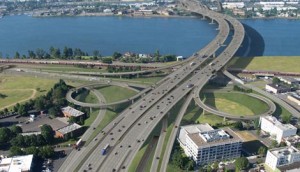Citizens standing in opposition to the Columbia River Crossing Light Rail Tolling project (CRC) project had a recent opportunity to voice their opinions before Oregon officials. Addressing the Joint Committee on Legislative Oversight on the Columbia River Crossing during their Mar. 16 informational meeting, a series of community leaders and industry professionals criticized current CRC plans on a variety of practical, financial, and environmental grounds.
Whether the presenter happened to be a state representative, a professor of urban planning, an environmental law expert or simply a concerned resident, a single universal judgment was echoed throughout the lengthy proceedings: The present CRC project is decidedly not the best way to solve the ongoing transportation problems caused by the existing Interstate 5 Bridge.Few described the rising level of congestion near the I-5 crossing as anything short of untenable, but the individuals who spoke at Friday’s meeting unvaryingly questioned the political rush to accept a bridge proposal deemed too impractical, too expensive, and too detrimental to the well-being of local communities and ecosystems. Taking public outcry over traffic congestion as a mandate for immediate and dramatic action, the CRC project may be endorsing the construction of a $10 billion dollar mistake.*
The immense cost of the project was at the heart of many of the concerns expressed at the Mar. 16 meeting. Criticizing the perceived need to “get started” on the project without a further period independent study, Plaid Pantry President Chris Girard insisted that “the greater risk is if we do get started with a plan we can’t pay for and end up inevitably going to taxpayers in a very big way.”
It is a sentiment that is shared by Oregon economist and current Chair of the Governor’s Council of Economic Advisors, Joe Cortright. Citing a dearth of available federal funding, poor CRC forecast models and a host of additional factors, Cortright decries the existing CRC financial plan, explaining, “It’s all about optimism. All of the forecasts for the money that they expect to get…are at the high end of the range….And, in fact, there is no financial contingency plan.”
These budgetary concerns become even more dire in light of Cortright’s estimation that 90% of large government projects like the CRC tend to experience cost overruns. These overruns are particularly pronounced in Oregon Department of Transportation (ODOT) projects, which have historically gone over budget by more than 100%. Taking all these economic factors into consideration, Cortright’s claim of excessive optimism on the part of the CRC begins to sound like something of an understatement.
The key word among those offering alternatives to the current CRC plan is “phasing.” An overwhelming majority of those testifying at the meeting endorsed discontinuing the CRC project as it currently stands in favor of a progressive construction model that addresses existing transportation needs in a series of consecutive stages. As Joe Cortright put it, “I think the risks argue for going with an incremental strategy where you break it down into smaller pieces, get results, and then see whether you can afford the investment.”
“By approaching the project in this manner, it is hoped that financial strains and overall community impact can be simultaneously dispersed and ameliorated. In order to realistically achieve these goals, however, alternative construction proposals must be seriously considered…and the CRC’s insistence upon a single bridge plan must be aggressively challenged.”
For the time being, at least, the Joint Committee on Legislative Oversight on the Columbia River Crossing seems open to examining practical solutions outside of the one currently moving forward. Fearing that “public love for this project has gone away,” State Representative Katie Eyre Brewer believes that further investigation of CRC alternatives is both prudent and necessary provided that this investigation is conducted with a “high level of integrity” and ultimately yields results.
“I am concerned that what we are doing is treading water,” said Representative Eyre Brewer, “and I really want to make sure that this information is actually used and that we have the guts to make the right decision whichever way it is.”
Whether or not they regard further proceedings as simply “treading water,” Committee Co-Chairs Lee Beyer and Cliff Bentz seem inclined to agree with their colleague. They ended the Mar 16 meeting by calling for additional hearings on the matter.
*The well-documented cost to taxpayers, if the CRC stays on budget, is $10 billion. This was established by the Cortright Report (PDF) which used data from an independent review panel hired by the governors of Washington and Oregon. (View the panel’s final report on which Cortright based his findings.)










